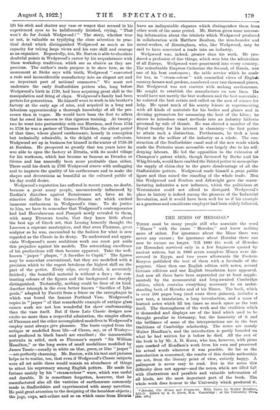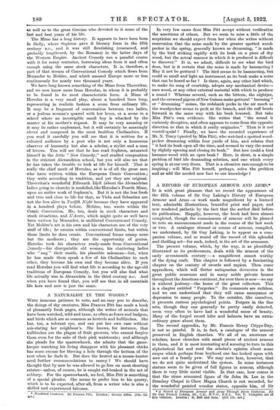THE MIMES OF H_ERODAS.*
THERE must be many people still who associate the word " Mimes " with the name "Herodas," and know nothing more of either. For ignorance about the Mime there was never any excuse ; for ignorance about Herodas there can now be excuse no longer. Till 1890 the work of Herodas (or Herondas) survived only in a few fragments quoted by ancient writers, but in 1890 seven complete Mimes were dis- covered in Egypt, and two years afterwards Sir Frederic Kenyon published the text of them with a facsimile of the papyrus. Since then one English edition with notes, several German editions and one English translation have appeared. And now all these have been superseded (or at least supple- mented) by the monumental and long-awaited Cambridge edition, which contains everything necessary to an under- standing both of Herodas and of his Mimes. The book, which is over 500 pages long (and costs three guineas), includes a new text, a translation, a long introduction, and a mass of learned notes which fill ten times as much space as the text itself. The thoroughness of the work and the erudition which it 'demanded and displays are of the kind which used to be thought peculiar to Germany, but the humanity of it and the brilliance of some of the interpretations are in the best traditions of Cambridge scholarship. The notes are mainly Walter Headlam's, and the introduction is partly founded on what he had written for it before he died. All the rest of the book is by Mr. A. D. Knox, who has, however, with pious care marked off Headlam's work from his own and preserved his actual words wherever it was possible. So far as the introduction is concerned, the results of this double authorship are not, from the literary point of view, entirely happy. A palimpsest is never easy to read. But in the notes this difficulty does not appear—and the notes, which are filled fult with illustrations and parallels and valuable information of all kinds, are the most important part of the book. The whole work does honour to the University which produced it, • Smarm, The Mimes and Fragments. With Notes by Walter nudism. Litt.D. Edited by A. D. Knox, M.A. Cambridge : at the University Press.
Ms. net.]
as well as to the great Grecian who devoted to it some of the last and best years of his life.
The Mime has a long history. It appears to have been born in Sicily, where Sophron gave it literary form in the fifth century B.C., and it was still flourishing (coarsened, and probably lengthened, by the Romans) in the latter days of the Western Empire. Ancient Comedy ran a parallel course with it for many centuries, borrowing ideas from it and often enough using the same stock characters. It is, therefore, a part of that stream of Conventional Comedy which flows from Menander to MoHere, and which amused Europe more or less continuously for nearly two thousand years.
We have long known something of the Mime from Theocritus, and we now know more from Herodas, in whom it is probably to be found in its most characteristic form. A Mime of Herodas is a very small play, about a hundred lines long, representing in realistic fashion a scene from ordinary life. It may be a fragment of conversation between two ladies, or a jealous woman's quarrel with her lover, or a scene in a school where an incorrigible small boy is whacked by the master at his mother's request. It may be very amusing or it may be rather unpleasant, but it will certainly be amazingly clever and composed in the most faultless Choliambics. If you read it carefully you will see that it is written for a cultured audience by a poet who is not only a humorous observer of humanity but also a scholar, a stylist and a man of letters. You will see that he has read Sophron, saturated himself in the Attic "New Comedy," and studied composition in the strictest Alexandrian school, but you will also see that he has taken the trouble to look at life for himself. That is really the chief merit of Herodas, as it is of all the great men who have written within the European Comic Convention ; they write according to tradition, and yet they are original. Theocritus's wonderful Fifteenth Idyll (about the Alexandrian ladies going to church) is modelled, like Herodas's Fourth Mime, upon an earlier work of Sophron's. But it is not the less fresh and true and close to life for that, as Viola and Sebastian are not the less alive in Twelfth Night because they have appeared in a hundred plays before. Moliere, too, wrote within the Comic Convention. He, too, deals in stock characters and stock situations, and L'Avare, which might quite as well have been written by Menander, is undiluted Conventional Comedy. Yet Moliere's art is his own and his characters are of the very stuff of life ; he creates within conventional limits, but within those limits he does create. Conventional forms cramp none but the mediocre ; they are the opportunity of genius. Herodas took his characters ready-made from Conventional Comedy—his disreputable old woman, his chattering ladies who " nag " their maids, his plausible salesman—but, when he has made them speak a f ow of his Choliambics to each other, they become his own and they become alive. If you read Herodas you will find what life is according to the age-old traditions of European Comedy, but you will also find what life actually was in Alexandria in the third century B.C. And when you have found that, you will see that in all essentials life here and now is just the same.



































 Previous page
Previous page